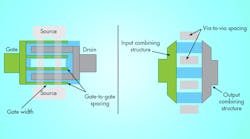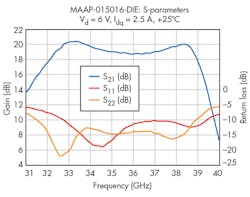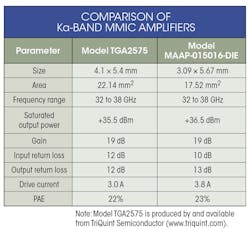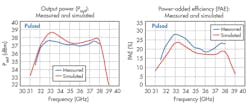This file type includes high resolution graphics and schematics when applicable.
Ka-band activity is on the rise, for both military radar systems and commercial point-to-point communications systems, thus driving the need for compact, efficient power amplifiers (PAs) to boost signals within those systems at Ka-band frequencies (26.5 to 40.0 GHz).1 Potential applications include television and broadband data services, commercial airborne communications, and military payloads.
Several previously published reports have demonstrated power, bandwidth, and efficiency for PAs in this frequency range. 2,3 The current report details the design, simulation, and measured performance of a compact broadband 4-W PA monolithic microwave integrated circuit (MMIC) developed by MACOM for Ka-band operation from 32 to 38 GHz.
The 4-W MMIC PA, a four-stage Ka-band PA chip—model MAAP-015016-DIE—from MACOM, is fabricated on a 2-mil, 0.15-µm, gallium-arsenide (GaAs), pseudomorphic high-electron-mobility-transistor (pHEMT) process. The design process employed semiconductor-foundry device models that were verified through a combination of small- and large-signal measurement. This characterization included S-parameter and load-pull measurements taken over wide temperature ranges using load-pull impedance tuners from Maury Microwave Corp.
To optimize RF performance in a multiple-gate finger cell at Ka-band, both the gate width and the physical length of the connecting structures were considered. The ideal arrangement was determined through simulation, which defined the basic cell structure utilized throughout the design. Figure 1 shows the GaAs cell layout, along with the layout of the multiple-cell combining structure. Measured and simulated load-pull data from NI AWR Design Environment simulation software was used to determine the optimum input and output impedances for the MMIC PA (Fig. 2).
Thermal Analysis
Another important factor in compact PA designs concerns thermal performance on a device cell level in terms of via arrangements and gate-to-gate spacing. For the Ka-band PA, optimal thermal performance was analyzed using SYMMIC thermal simulation software from Capesym, a Software Alliance partner with National Instruments (formerly AWR Corp.). Thermal analysis was critical since the amplifier must meet performance levels under both continuous-wave (CW) and pulsed operating conditions.
Each device cell was stabilized individually using a parallel resistive-capacitive (RC) arrangement, and overall circuit stability was verified under typical drive conditions. Thermal imaging analysis of the die revealed a peak temperature rise of 60°C above the PA’s base temperature, corresponding to a mean time to failure (MTTF) of 5 × 107 hours. Electrostatic-discharge (ESD) diodes were included on the PA die, with measured performance levels for charged device model (CDM) and human body model (HBM) ESD conditions graded as Class 1 and 1B, respectively.
The PA’s design and measurement reference planes are to an external 50-⦠transmission line on an alumina substrate. Bond-wire transitions were optimized by means of three-dimensional (3D) electromagnetic (EM) software simulation using the Analyst and AXIEM EM simulators within the NI AWR Design Environment software. For accuracy, an application circuit used to evaluate the Ka-band MMIC PA leverages a baseplate arrangement designed to match the GaAs die’s coefficient of thermal expansion (CTE). Regarding measurements, the RF input/output pads are bonded to an external probe pattern, so that the test arrangement replicates the 3D EM simulation of the transition. External decoupling capacitors help improve the low-frequency stability of the MMIC PA.
Thanks to the decoupling capacitors, the MMIC PA can operate efficiently under both drain pulsed and CW conditions. Under CW conditions, power dropped by only about 0.5 dB compared to pulsed conditions (see the table). Compared to a competitive device, the MAAP-015016-DIE MMIC PA provides similar performance but with greatly reduced real estate and improved output-power performance across the Ka-band frequency range.
Test Results
The Ka-band amplifier’s small-signal performance was measured for pulsed operating conditions (Fig. 2, again). The small-signal gain is about 19 dB, with input and output return losses of better than 10 and 13 dB, respectively, across the band of interest. While output power varies across the wide frequency range for various input-power levels, the amplifier can deliver about +37 dBm output power at 1-dB compression across a bandwidth of 33 to 38 GHz, with a rated output power of +36.5 dBm at 1-dB compression. Across the full 32-to-38-GHz band, the device also achieves the required +36-dBm output power at 1-dB compression.
Figure 3 shows the power-added-efficiency (PAE) performance for pulsed operation. As the data reveals, the amplifier achieves a PAE of between 18% and 27% across the full frequency band.
A comparison of measured results with simulated performance as predicted with NI AWR Design Environment software (Fig. 4) shows good correlation that validates the design process. As is typical, output power performance measured slightly lower than simulation, while measured PAE is slightly better than predicted by simulation. Despite the variation in magnitude of these parameters, the similar shape of the response curves indicates that the circuit was accurately characterized in simulation.
The MAAP-015016-DIE four-stage Ka-band PA provides 4-W output power with 19-dB typical gain from 32 to 38 GHz in a small-sized chip. It was designed for RF/microwave performance as well as for thermal longevity, with the aid of modern computer-aided-engineering (CAE) software simulation tools. Fabricated with a reliable 0.15-µm GaAs pHEMT semiconductor process, the PA is a strong candidate for both military and commercial applications at Ka-band frequencies, as more systems extend toward these higher frequencies.
Thomas Young is an engineer at MACOM.
MACOM, 100 Chelmsford St., Lowell, MA 01851; (800) 366-2266, (978) 656-2500, FAX: (978) 656-2804.
References:
1. Deepak Gupta, “A Market Forecast For High-Frequency, Space-Qualified, TWTs,” Sat Magazine, March 2012.
2. C. F. Campbell, D. C. Dumka, Kao Ming-Yih, and D. M. Fanning, “Design and Performance of a High Efficiency Ka-Band Power Amplifier MMIC,” 2010 IEEE Compound Semiconductor Integrated Circuit Symposium (CSICS), October 3-6, 2010, pp. 1-4.
3. S. J. Mahon et al., “35 GHz Power Amplifier MMICs using 6-inch GaAs pHEMT Commercial Technology,” 2008 IEEE MTT-S International Microwave Symposium, Atlanta, GA, Symposium Digest, pp. 855-858.






